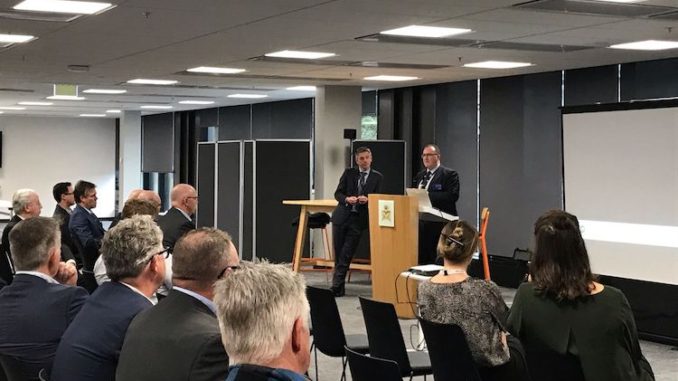LoD: You’re professional experience spans several sectors and job roles. What are the key strands that connect these and that have led you to your current role as NZDIA CEO?
IH: I was trained as an aircraft engineer with Marshall Aerospace and Defence Group in England a long time ago. I loved aircraft and aviation, and working with the military came at an early age when I started my apprenticeship at the age of 16. I was on a team that carried out modifications for the fleet that went down to Stanley for the Falklands War, and in the process garnered a very good view into how the military works and how things change during a conflict situation. It was a very interesting time.

Because I was on that team I got my first really good exposure to managing people and stakeholders because we did six months’ work in six weeks.
I was seconded for a while to RAF Lyneham and then became an engineer on the road for many years, before moving into aviation recruitment. These were the glory days of recruitment in England when we were supplying teams all over Europe for the winter programmes.
That provided very good experience in learning how to manage people and projects and dealing with the stakeholder expectations aspect of projects. Our guys came in for six months of the year to Germany and did all the heavy maintenance on the aircraft, and I had a knack of relationship building and stakeholder management and really enjoyed managing people and leading the teams.
Hopefully these were the strands that the [NZDIA] Board saw when they asked me to take the role.. plus I’m very calm, and I think that’s an asset when you’re dealing with Defence and military. The limelight side of it was never of interest to me! I always preferred being the one in the background that quietly made everything work.
LoD: What is your vision for the NZDIA, and which direction(s) do you see the Association heading over the next couple of years?
IH: The first direction is ‘backwards’, a retro-step back to being a more face-to-face, hand-shaking, eye-to-eye contact operation. I understand the need for virtual events, but it wasn’t really how I – or members generally – envisaged the NZDIA being. The second direction is to expand the scope of what the NZDIA does.
The first is relatively easy. It was really about picking up the phone and talking to the members and main stakeholders, and asking “What is it that you actually want? What do you like? What don’t you like? What haven’t you liked? What do you see different?” And it was almost unanimous that they wanted to go back to being in the same room as the people they wanted to talk to, and having the opportunities to network afterwards.
The second direction is around broadening our scope. We shouldn’t just be limited to Defence, or New Zealand. What opportunities can we provide for New Zealand industry, whether it’s the ADF, other suppliers to Defence in Australia (which is where I intend to start) or into Asia Pacific and Europe (which is the plan)?
READ MORE
- The Interview: Andrew Bridgman, Secretary of Defence
- REFLECTIONS, AS THE GOVERNMENT’S LEAD CIVILIAN ADVISER ON DEFENCE MATTERS
We’ve already started liaising with Corrections, Intelligence, Fire and Emergency, Police, etc, and bringing these other government agencies into the fold. They won’t necessarily be members, but they’ll be a part of the team with a view to two things: (i) the Defence and MoD people in the room will have access to these other agencies, the agencies will have access to the senior Defence staff present, and – more importantly for the membership –they’ll have access to these other government agencies.
It’s a slow process, but there’s been ongoing conversations between the NZDIA Board and the senior stakeholders, and it’s a direction that everyone wants to go in. We have to be seen to be offering the members value. We can’t stay still, we have to move forward, and part of that is encompassing other agencies, which offers members greater access to opportunities. We can only do that if we’re all in the same room talking to each other. The more opportunities we can offer the membership the better.
We’ve also been building up a great relationship with NZTE. Although the upcoming DSEI event is in Europe, all NZ industry can attend the event virtually, which is a great opportunity for them. In addition, and in conjunction with NZTE, we’ll also have a representative there in person who can connect with exhibitors at the event on behalf of any member organisation. This is a first big step in providing New Zealand industry with wider opportunities.
LoD: How would you describe the current state of Defence – Industry engagement?
IH: It’s not necessarily as simple and straight forward as it should be. There is a sense, it seems, that the NZDF and MoD have been inherently suspicious of industry’s agenda and objectives, and quite often industry feels that they don’t get enough information and communication back on opportunities. But it’s actually moving in a very positive record.
There’s been some announcements recently on procurement that we’ve been asked by Defence to put out to our membership via the newsletter. Although such things do go out via GETS, etc, it’s wonderful that Defence is actually asking us to do this on their behalf because it shows the strengthening relationship. Communication is key, and I’ve been working hard to get communication working both ways.

LoD: Having been in the role now for a number of months, what do you see as the key challenges currently facing the NZDIA?
IH: At the moment it’s Covid of course. We’ve had to postpone the CEO lunch, which is a real shame, as well as the events we’ve got on 6th and 7th October.
Cyber security is another ongoing issue. We’ll need to ensure that we’re ahead of it and that the information we have on our website and database, etc. is safe and secure.
The main challenge for the NZDIA for me as the CEO is making sure that the members see that they’re getting value, which will benefit from our expanding scope and bringing in a wider range of opportunities.
LoD: What re the continuing challenges posed by Covid for the Association?
IH: One of the first things the Board asked me to do was an updated emergency plan and risk matrix in place for the organisation, and obviously that had to encompass the Covid chaos at that time. We have a plan, and if we have to we’ll revert to virtual meetings as a last resort, bearing in mind that one of the prime comments from the members when I joined was that they really didn’t see value in the big virtual events.
Now with his feet firmly under the desk, Line of Defence speaks with New Zealand Defence Industry Association CEO Ian Harman about Defence-Industry engagement, Covid challenges, and his vision for the NZDIA.
We’re going step by step to see what the government does, and we’re adjusting our plans accordingly. In the first instance, we’re going to delay and postpone events with a view that we can hopefully return to meetings around mid- to end-October-November. If it becomes a much bigger disruption then we’ll simply have to rely on virtual events. In the meantime , we’re liaising via teams and we’ve been busy. We’re proceeding in the best virtual way we can.
LoD: Over the years there has been talk of broadening the scope of the NZDIA beyond its traditional defence focus to one encompassing the broader National Security sector. Where does this currently stand?
IH: The original plan was to start bringing the other agencies into our meetings during the first quarter in 2022, but I expect that it may even happen a little bit before then. We invited Amotai to come along to the last meeting, and we’ve had people such as Ron Mark and Des Ashton come along to recent meetings, which provides opportunities for members to talk to people who are incredibly knowledgeable and well connected.
LoD: Broader Outcomes and the 5% Maori procurement target are topical for suppliers of government and defence. How seriously do you see these being taken on board by stakeholders, particularly Primes?
IH: We’re very supportive of the Government Procurement Rules and particularly the rules around Broader Outcomes. As mentioned, we’ve already been liaising with Amotai, and we are very supportive of developments in that space.
We don’t have a stand on Broader Outcomes. It’s not our job to have a stand on it; our job is to support it and to then see where the opportunities are for New Zealand industry, and if that includes a percentage of Maori owned businesses then that’s great. It’s then about how can we assist in getting them involved.
I thought what Paul Howard said at the last Member Meeting around 5% Maori procurement was excellent: “This is what the government has asked us to do, it’s not going to happen overnight but it’s going to happen.”
Where the NZDIA can really add value is in having the conversations and being able to say “This is the number of companies that identify as Maori, and this is the number of companies that have this capability.” We can join the dots and bring them together. We’re using the MBIE requirements to gather this information from new members so that we can report on it.
Part of what we can do going forward is to provide as much information on capability in New Zealand across the board, including the Broader Outcomes requirement, that the government needs.




